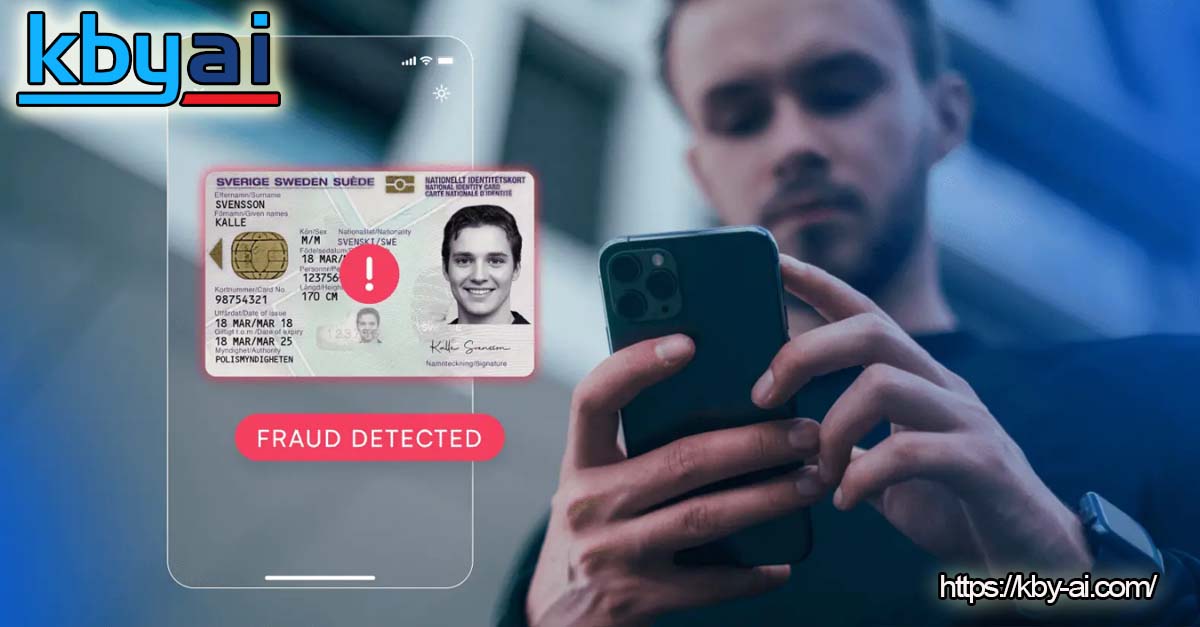KYC fraud has a strange habit — it never truly rests. It simply changes its disguise. One day it’s a counterfeit passport printed on glossy paper, the next it’s an AI-generated “individual” who looks more realistic than most selfies online.
Take 2025, for instance. A new fintech startup launches in Asia, generating excitement and rapid user growth. Then suddenly — disaster. Fake accounts begin to slip through the cracks, not made by real users, but by bots powered with synthetic identities. Funds disappear, regulators start asking questions, and customer trust vanishes almost instantly.
This isn’t a futuristic scenario. It’s the reality we’re facing right now. KYC fraud has evolved, supercharged by generative AI, deepfake technology, and advanced identity theft tactics. The old defenses are no longer enough.
Here’s what we’re about to unpack:
• Why KYC fraud is more dangerous than ever in 2025 and what it looks like.
• The sneaky new tricks fraudsters are pulling.
• How SDK-based systems are stepping up with real-time liveness checks on-device processing, and other clever tools.
• Practical strategies so your business doesn’t end up the next cautionary headline.
Let’s dig into KYC-fraud.
What Is KYC Fraud?
KYC fraud occurs when individuals bypass identity verification using stolen, fabricated, or even AI-generated information. In the past, this might have involved fake photocopies or forged IDs. Today, it’s far more advanced — with deepfake face swaps and organized fraud networks operating at industrial scale.
Why does it matter? Because the consequences are severe:
• Financial loss. Chargebacks, stolen funds, and regulatory fines can pile up fast.
• Damaged reputation. Customers quickly lose trust in platforms that fail to protect them.
• Regulatory pressure. Compliance standards are tougher than ever, and mistakes are costly.
KYC fraud has evolved beyond a mere compliance task — it’s now a matter of survival.
The New Threats in 2025
1. AI-Generated Identities (Synthetic ID Fraud)
Fraudsters can now create entire identities from scratch using generative AI. Photos? Done. Fake social histories? Check. Digital “footprints”? Absolutely. These AI-crafted profiles can slip past traditional verification systems with surprising ease.
For example, several European banks reported loan applications submitted by entirely AI-generated individuals. None of these applicants existed, yet the paperwork fooled basic identity checks.
2. Deepfake Videos and Face Swaps
Deepfakes have moved beyond entertainment — they’re now tools for fraud. Imagine a customer service agent interacting with a video that seems like a real user, only it’s a perfectly animated fake face.
A striking case: In 2024, employees at a multinational company wired millions after receiving a deepfake video of their CEO requesting the transfer.
3. Stolen and Recycled Biometrics
The nightmare scenario: someone steals your biometrics — a fingerprint, face scan, or other unchangeable identifier. Systems that store this data insecurely are essentially treasure troves for fraudsters.
Once stolen, biometric data is virtually impossible to recover or replace.
4. Automated Bot Attacks
Bots never sleep. AI-driven bots can attempt thousands of sign-ups in hours, testing countless combinations until one succeeds.
It’s like letting an army of pickpockets roam your store and hoping none of them walk away with anything.
5. Cross-Border Fraud Rings
KYC fraud has gone global. Networks trade stolen identities and AI tools on dark web markets, targeting banks, healthcare systems, and e-commerce platforms in coordinated waves.
Think of it as an international “fraud supply chain.”
Why Old Systems Are Failing
Traditional KYC fraud tools weren’t designed for today’s fast-paced fraud landscape. Many still depend on slow document uploads, cumbersome manual reviews, or single-step ID scans.
The issues are clear:
• Too slow. Customers abandon the process when it drags on.
• Too weak. Static checks can’t stand up to deepfakes.
• Too centralized. Cloud-only systems are vulnerable and often suffer from latency.
While fraudsters are running at full speed, these legacy systems are barely keeping up.
Enter SDK-Based Systems: A Game-Changer
So, what’s changing the game? SDK (Software Development Kit)-based verification systems. These tools integrate directly with business or mobile apps, accelerating KYC fraud processes while making them much harder for fraudsters to bypass.
Here’s why they’re essential:
1. Real-Time Liveness Detection
Forget the old “blink at the camera” method. Modern SDKs analyze depth, texture, micro-movements, and even subtle light reflections to verify that a face is truly live.
Why it matters: Deepfakes can replicate many features, but they struggle to mimic the natural, nuanced behavior of a live human face.
2. On-Device Processing for Privacy
Instead of sending sensitive biometric data to the cloud, many SDKs handle processing directly on the user’s device.
• Faster results. No waiting on server round-trips.
• Greater trust. Users know their data isn’t being transmitted across networks.
3. Multi-Layered Verification

Effective KYC fraud combines several checks, such as:
• Face recognition
• Document scans
• OCR (reading ID text)
• ID number or license plate matching
A fraudster might bypass one layer, but slipping past all of them? Nearly impossible.
4. Seamless User Experience
Nobody enjoys clunky onboarding. SDKs integrate smoothly with apps, speeding up registration and making the process mobile-friendly. Customers appreciate the ease, while scammers hit roadblocks.
5. Continuous Updates Against Emerging Threats
Fraud evolves constantly. Regular SDK updates ensure your system stays ahead, learning to detect the latest tricks before they become widespread.
Real-World Example: A Fintech in Southeast Asia
At the start of 2024, a digital bank in Southeast Asia was struggling with rampant fake ID fraud. Within three months of adopting an SDK featuring passive liveness detection, fake account creation dropped by 87%. The bonus? Customer onboarding became 40% faster.
This is what happens when security and convenience finally go hand in hand.
The Role of Regulation in 2025
Governments are taking fraud seriously. New regulations now require:
• Real-time verification: Delays are no longer acceptable.
• Privacy-first design: User data must be protected, or businesses face penalties.
• Demonstrable reliability: Regulators expect firms to show they have systems capable of detecting and preventing fraud.
For many companies, this makes SDK-based verification not just a “nice-to-have,” but an essential part of compliance.
How Businesses Can Prepare
So, how can you prepare for this new wave of fraud?
• Adopt SDK-Based Verification: Choose solutions with liveness detection, on-device processing, and multi-layered checks.
• Train Your Team: Technology helps, but employees also need awareness and adherence to best practices in customer care.
• Monitor Fraud Trends: Stay alert — deepfakes, synthetic IDs, and other tactics are constantly evolving.
• Protect the User Experience: Ensure customers remain secure without compromising convenience.
• Choose the Right Partners: Work with experts who understand the landscape and have a proven track record.
Beyond the Buzzwords: Why 2025 Fraud Feels Different
In 2025, KYC fraud isn’t just sneaky — it’s incredibly sophisticated. Gone are the days of forged signatures or photocopied IDs. Today’s fraudsters rent cloud servers, train machine learning models, and create entire “people” who don’t exist. Faces, voices, documents — all fabricated out of thin air. The scary part? They look so real, even your grandmother might swear she’s talking to you.
This isn’t a sci-fi scenario. Founders of new fintech apps know the struggle all too well. They launch their platforms, celebrate an influx of new users, and then — disaster. Many of those sign-ups turn out to be fake accounts generated with stolen data and AI tricks. Money disappears, regulators close in, and the trust they painstakingly built vanishes in an instant.
Why Fraudsters Love Old Systems
The reality is that legacy KYC fraud tools are easy targets — like old suitcase locks that look secure but can be opened with a simple pen.
Consider the typical process: upload an ID, snap a quick selfie. It seems fine on paper. In practice, however:
• Too slow: Who wants to wait hours just to prove their identity?
• Too clunky: A single failed upload can make customers abandon the process.
• Too predictable: When fraudsters can anticipate the system’s steps, bypassing it becomes easy.
In 2025, predictability is basically an open invitation — and fraudsters are always quick to RSVP.
SDKs: Fighting Fraud Without Killing the Vibe
This is where SDK-based systems change the game. Think of them as guard dogs that don’t just bark at intruders — they sniff out fakes before they even reach the door. Instead of sending data off to a distant server, SDKs perform checks directly on the user’s device. Real-time liveness detection, micro-movement analysis, and texture scanning all happen instantly.
It’s no longer just a “blink at the camera” test. SDKs can determine whether a person is actually present or if it’s just a high-quality video loop — like having a bouncer who not only checks IDs but can tell if someone is breathing. No CGI clone is getting past that.
The best part? Users barely notice. A quick tilt of the head, a brief scan — done. Security works seamlessly in the background without disrupting the experience.
Stories from the Field
One of my favorite examples comes from a digital wallet service in Africa that was drowning in fake sign-ups. Bots were creating thousands of accounts every week, draining resources and causing chaos. The turnaround was dramatic after they implemented an SDK with tiered checks, including face recognition, document scanning, and passive liveness detection. Fraud dropped by over 80%, and interestingly, real users started signing up more frequently, feeling that the process was safer and more trustworthy.
The sweet spot is when stronger security doesn’t feel like barbed wire, but rather a gentle tap on the shoulder saying, “Yep, you’re good to go.”
What This Means for Businesses
So, what’s the next move? How do you stay secure in a world where AI is working for both sides? The answer is simpler than it seems: meet AI with AI.
Businesses that rely on outdated systems are leaving the front door wide open. Those that adopt SDK-based KYC fraud aren’t just reducing fraud losses — they’re also showing regulators they take compliance seriously. Even more importantly, they’re sending a strong signal to customers: your identity is safe here.
Fraud in 2025 is fierce, no question. But with the right systems in place, it doesn’t get to write the story — you do.
Conclusion:
KYC fraud in 2025 isn’t about sloppy forgeries anymore. It’s AI-driven, fast, and global. Companies still relying on outdated tools are falling behind — and paying the price. SDK-based systems are rewriting the rules: real-time liveness detection, on-device privacy, and multi-layered defenses help businesses stay ahead of fraudsters without slowing down customers.
At KBY-AI, we believe security shouldn’t be a roadblock — it should be an advantage. Our SDK solutions are designed to tackle both today’s challenges and tomorrow’s surprises. Companies get the tools they need to prevent scams, stay compliant, and build trust. Are you ready to stay one step ahead? Let’s work together to make the digital world safer.
FAQs
1. What is KYC fraud?
KYC fraud occurs when criminals bypass identity verification using stolen, fake, or AI-generated information. In 2025, this includes deepfakes, synthetic IDs, and automated bot attacks.
2. Why are SDK-based systems better than legacy KYC fraud tools?
SDKs enable real-time, on-device checks with advanced liveness detection inside KYC fraud system. Compared to traditional cloud-only systems, they’re faster, more secure, and much harder for fraudsters to bypass.
3. How do SDKs protect customer privacy?
Many SDKs process sensitive data directly on the user’s device, reducing the risk of theft that comes with sending or storing information on central servers.
4. Are SDK-based solutions compliant with regulations?
Yes. With privacy-first designs and support for frameworks like GDPR, most SDK verification systems are built to meet global KYC and AML requirements.
5. Which industries benefit most from SDK-based KYC fraud?
Industries handling sensitive data and facing high fraud risk benefit most, including healthcare, e-commerce, banking, and fintech.


